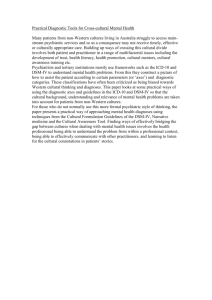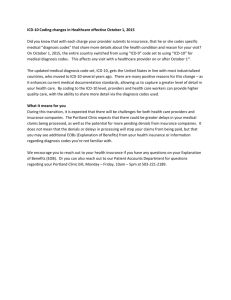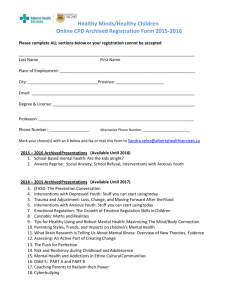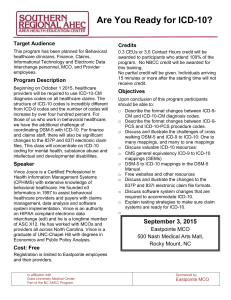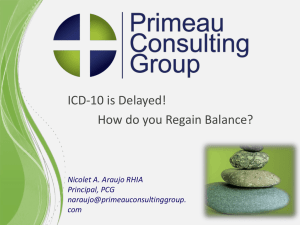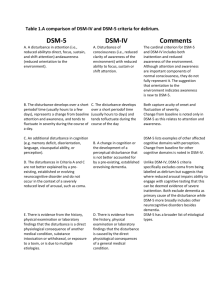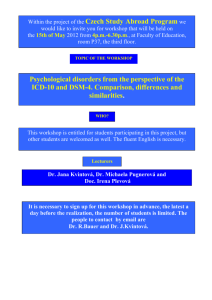PowerPoint Slides
advertisement
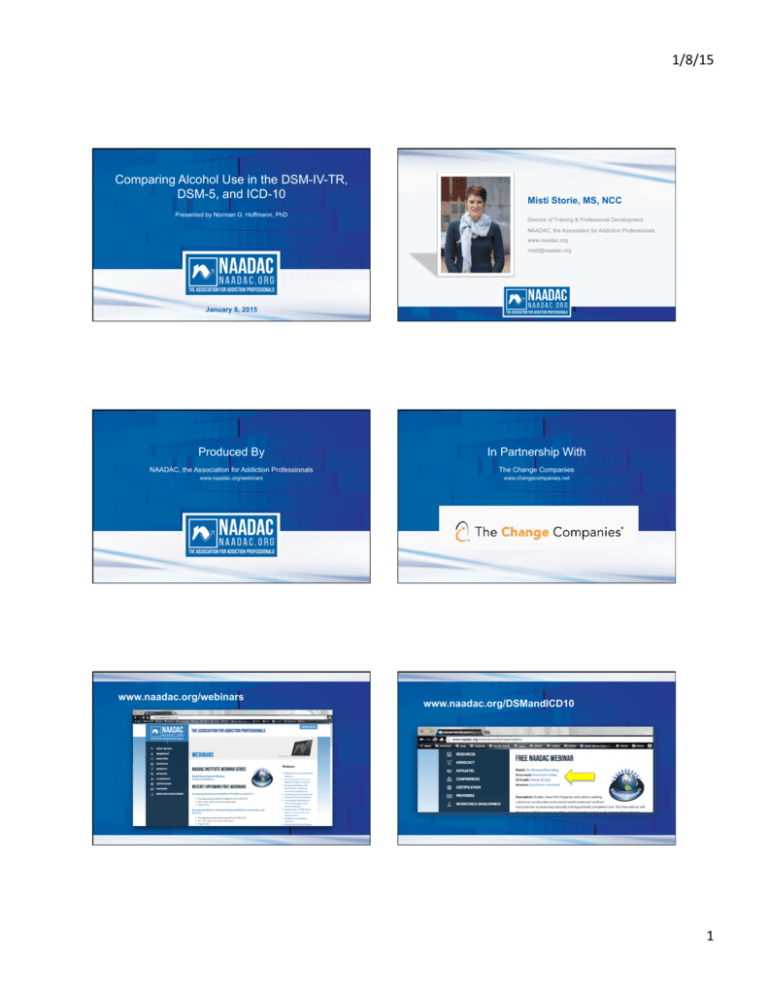
1/8/15 Comparing Alcohol Use in the DSM-IV-TR, DSM-5, and ICD-10 Presented by Norman G. Hoffmann, PhD Misti Storie, MS, NCC Director of Training & Professional Development NAADAC, the Association for Addiction Professionals www.naadac.org misti@naadac.org January 8, 2015 Produced By In Partnership With NAADAC, the Association for Addiction Professionals The Change Companies www.naadac.org/webinars www.changecompanies.net www.naadac.org/webinars www.naadac.org/DSMandICD10 1 1/8/15 CE Certificate Cost to Watch: Free Using GoToWebinar – (Live Participants Only) To obtain a CE Certificate for the time you spent watching this webinar: CE Hours Available: 1.5 CEs 1. Watch this entire webinar. § Control Panel 2. Pass the online CE quiz, which is posted at CE Certificate for NAADAC Members: Free § Audio (phone preferred) www.naadac.org/DSMandICD10 3. If applicable, submit payment for CE certificate or join NAADAC. CE Certificate for Non-members: $20 4. A CE certificate will be emailed to you within 21 days of submitting the quiz. § Asking Questions § Polling Questions § Follow-up Emails Webinar Presenter Webinar Learning Objectives 1 2 3 4 Describe the similarities and differences between the DSM-IV and DSM-5 diagnostic criteria for alcohol use Identify the five DSM-5 criteria found primarily among those with a severe diagnosis of alcohol dependence Describe the similarities and differences between the DSM-5 and ICD-10 diagnostic criteria for alcohol dependence Explain when and why one might use the ICD-10 diagnosis of unspecified substance disorder Norman Hoffmann, PhD Phone: 828-454-9960 Email: evinceassessment@aol.com Overview Overview • We will be focusing on the comparisons among diagnostic formulations from the DSM-IV and DSM-5 to the ICD-10 criteria • The change from the DSM-IV to the DSM-5 marks a shift from a categorical to a dimensional diagnostic perspective • However, we will also be covering issues related to how individual groups of criteria may be more important than the formal diagnosis • The mandate to use ICD-10 diagnostic codes in 2015 requires matching the dimensional DSM-5 diagnoses back to a categorical formulation • This out of the box perspective can be integrated with the concept of an outcomes-based approach to individualized treatment that, in theory, is superior to the common requirement for using evidence-based treatment models • Empirical evidence suggests that irrespective of the diagnostic formulation used, some criteria indicate a more severe and chronic condition 2 1/8/15 Historical Background Historical Background • DSM-II (1968-1980) • DSM-III-R (1987-1994) • Diagnoses: Episodic excessive drinking; habitual excessive drinking; and alcohol addiction • Addiction defined as the inability to go one day without drinking and experiencing withdrawal • DSM-III (1980-1987) • Diagnoses: Abuse and dependence • Dependence defined as having tolerance and/or withdrawal plus pathological use and/or impairment in social or occupational functioning Empirical Perspective • To my knowledge, there is no rigorous evidence to support any of the previous diagnostic formulations • To a large extent, this is also true for the DSM-5 • Diagnoses: Abuse and Dependence • Dependence defined as having three or more positive criteria out of nine criteria • DSM-IV (1994-2000) • Diagnoses: Abuse and dependence • Dependence defined as having three or more positive criteria out of seven criteria • DSM-IV-TR (2000-2013) • Essentially identical to the DSM-IV DSM-5 Substance Use Disorder Criteria 1. Use in larger amounts or longer than intended 2. Desire or unsuccessful effort to cut down 3. Great deal of time using or recovering 4. Craving or strong urge to use • Since the DSM-III-R tolerance and withdrawal have moved from required criteria for dependence to being two among 11 with the advent of the DSM-5 5. Role obligation failure 6. Continued use despite social/interpersonal problems • The DSM-5 removes the artificial categorizing of some criteria as being for abuse and others for dependence by eliminating both terms and replacing them with a dimensional concept of severity based on the number of positive criteria 7. Sacrificing activities to use or because of use 8. Use in situations where it is hazardous DSM-5 SUD Criteria continued DSM-5 Initial VS. DSM-5 Final 9. Continued use despite knowledge of having a physical or psychological problem caused or exacerbated by use • Initially the proposed DSM-5 had two diagnostic categories: moderate and severe defined by 2-3 and 4+ positive criteria – conforms best to abuse vs. dependence classification 10. Tolerance 11. Withdrawal • Final formulation has three diagnostic categories: mild (2-3), moderate (4-5), and severe 6+ positive criteria) Criteria 1-4 relate to use • Original “moderate” becomes “mild” – no empirical foundation for either distinction Criteria 5-8 relate to behavioral issues associated with use Criteria 9-11 relate to physical/emotional issues 3 1/8/15 Unresolved Issues • Are the divisions among the DSM-5 mild, moderate, and severe diagnoses optimal? • What are the clinical implications for the matches and mismatches with the DSM-5 and ICD-10 diagnoses? • What are the financial implications if the DSM-5 proposed matches or the actual ICD-10 criteria are used for reimbursement? • The ICD-10 has two forms; will that make a difference for reimbursement? Audience Polling Question #1 Do you feel that the dimensional diagnoses of the DSM-5 are more appropriate than the categories of the DSM-IV-TR? Sustained Remission Remission vs. Recovery • No positive diagnostic findings (other than craving) for 12 consecutive months • Remission is clearly defined by the DSM-5: no problems irrespective of continued use • Substance use is NOT part of the remission definition • Recovery has many definitions • This remission definition is appropriate for both misuse and chronic addiction • The concept of recovery tends to involve much more than remission • Possible levels of outcome: 1) abstinence without problems; 2) some use without problems; 3) use with sub-diagnostic problems; 4) meets current diagnosis • Treatment is typically not reimbursed for some aspects of recovery – e.g., serenity, interpersonal relationships, employable, etc. • Payment for treatment has the primarily expectation for remission not recovery DSM-5 Criteria Differentials • All criteria are not equal in implications • Some criteria are found predominately among those with the severe alcohol or other substance use disorder diagnoses Distribution of Positive Alcohol Criteria for 6,871 Males DSM-IV Criteria Based on SUDDS-IV Results 1. Unplanned use DSM-5 Designations No Dx Mild Mod. Sev. Pop. Prev. 2% 8% 11% 79% 27% <1% 4% 7% 88% 21% 3. Time spent using 2% 6% 11% 81% 28% 4. Craving/compulsion 1% 3% 7% 89% 21% <1% 3% 9% 88% 25% 3% 13% 14% 70% 34% • Other criteria are more common among the mild to moderate alcohol use disorder group 2. Unable to cut down • Tolerance and dangerous use are actually common among those with no diagnosis 5. Role failure 6. Social Conflicts 4 1/8/15 Distribution of Positive Alcohol Criteria for 6,871 Males DSM-IV Criteria Based on SUDDS-IV Results 7. Sacrifice activities 8. Dangerous use 9. Contraindications 10. Tolerance 11. Withdrawal Self-medication DSM-5 Designations Pop. Prev. No Dx Mild Mod. Sev. <1% 2% 9% 89% 8% 15% 3% 15% 10% 12% 11% 11% <1% 76% 11% 3% 5% 62% 66% 7% 9% 90% 11% 75% 7. Sacrifice activities DSM-5 Designations No Dx Mild Mod. DSM-IV Criteria Based on SUDDS-IV Results DSM-5 Designations No Dx Mild 8% 9% 80% 31% 36% 0% 2% 6% 92% 24% 30% 3. Time spent using 0% 1% 7% 92% 26% 33% 4. Craving/compulsion <1% <1% 3% 96% 23% 19% 5. Role failure <1% 5% 5% 90% 26% 27% 6. Social Conflicts 3% 10% 10% 77% 33% Sev. Pop. Prev. DSM-5 SUD Criteria Primarily In Severe Designation The “Big Five” 4% 93% 25% • Criteria 2: Wanting to cut down/setting rules 8. Dangerous use 6% 8% 9% 77% 29% • Criteria 4: Craving and/or compulsion to use 9. Contraindications 3% 9% 10% 78% 32% • Criteria 5: Failure at role fulfillment due to use 10% 5% 10% 75% 32% • Criteria 7: Sacrifice activities to use 11. Withdrawal 0% 2% 3% 95% 20% Self-medication % % % % % Sample of Alcohol Diagnostic Documentation 2 3 4 X X X Case 1 Severe X Case 2 Mild X X Moderate Moderate X X Case 3 Case 4 X X 5 6 7 8 X X 3. Great deal of time using 10. Tolerance 9 10 11 X X X X X X • Criteria 11: Withdrawal symptoms CASE 3: Positive DSM-5 Criteria Diagnostic Criteria 1 Pop. Prev. 3% 3% Alcohol Diagnosis Sev. 2. Unable to cut down <1% 10. Tolerance Mod. 1. Unplanned use 23% Distribution of Positive Alcohol Criteria for Females DSM-IV Criteria Based on SUDDS-IV Results Distribution of Positive Alcohol Criteria for 801 Females X X *Cases 3 & 4 with the same diagnosis may have different prognoses if the Big Five are related to outcomes X 1. Unplanned use: more or longer use 8. Use in hazardous situation (impaired driving) 6. Recurrent interpersonal conflicts Conclusions • No loss of control indicated • Misuse and possible irresponsible behavior • Moderation may be a reasonable initial goal 5 1/8/15 CASE 4: Positive DSM-5 Criteria 1. Unplanned use: more or longer use 2. Desire/efforts to cut down Implications for Disposition • Education and brief counseling may be appropriate for majority of mild use disorders 4. Craving/compulsion to use 5. Role obligation failures 7. Sacrificing activities to use Conclusions • Abstinence will virtually always be required to achieve remission for those with a severe diagnosis • For those with a moderate diagnosis, the pattern may be as important as the number of positive criteria • Loss of control clearly indicated • Positive on 4 of the “Big Five” • Abstinence indicated goal for recovery • Those positive on any of the Big Five criteria should be carefully evaluated regarding the current and projected trajectory of their condition Final Criticism of the DSM-IV CLINICAL (Medical) NECESSITY • Loss of control not required for a dependence diagnosis – e.g., tolerance, spending time using, and occasionally drinking more/longer than intended – got the chronic diagnosis • Some abuse criteria are stronger indications of a serious condition than some dependence criteria • Role obligation failure is a Big Five criterion • Tolerance is often seen in mild cases or even among those with no diagnosis • Persons in the severe designation with positive “Big Five” findings will require a more intensive and longer continuum of care to achieved treatment effectiveness • Persons in the mild designation typically will benefit from shorter & less intensive interventions to achieve efficiency • Each treatment plan can be informed by prior empirical outcome data on comparable cases and modified based on the individual’s treatment response Sample Hypotheses for Clinical Practice • Hypothesis #1: Clients positive on three or more of the “big five” will require initial residential placement and/or more intensive and longer continuum of care to achieve good results • Hypothesis #2: Clients in mild or moderate designations without any positive findings on the “big five” may be able to moderate or stop use with less intensive and briefer services Audience Polling Question #2 Do you plan to use the Big Five in your clinical practice? 6 1/8/15 DSM-IV vs DSM-5 Alcohol Diagnoses Males N = 6,871 ICD-10 Clinical Diagnostic Criteria Females N = 801 • Harmful use: actual physical, mental, cognitive harm (does not count C6 or C8) 100% 100% 80% 80% 60% 60% (f) Continued despite actual harms – C9 e (e) Neglect of interests/time spent using – C3, C5, C7 No Dx en de nc x e (d) Tolerance – C10 Mild ep D e (c) Withdrawal – C11 Mod. D ep en de x D us o Ab N nc e No Dx us 0% 0% Severe D Mild 20% o 20% (b) Difficulty controlling use – C1 & C2 40% N Mod. (a) Desire/compulsion to use – C4 Ab Severe 40% • Dependence: any three of the following: ICD-10 Research Diagnostic Criteria ICD-10 and the Big Five • Harmful use: • actual physical, mental, cognitive harm • impaired judgment – C8 • dysfunctional behaviors – C6 • The criteria for dependence in the ICD-10 encompass the concepts of the Big Five • Dependence: same as with the clinical version • The expectation would be that the ICD-10 diagnosis of dependence would likely be equivalent to the severe designation of the DSM-5 or moderate with Big Five positives • The research version is newer • All DSM-5 criteria are accounted for with the research criteria – but the combinations might not correspond to the DSM-5 matches – e,g. 2 dependence criteria no ICD-10 Dx • Tolerance & harm from use are the exceptions • The problem arises with the fact that there are two versions of the ICD-10 where harmful use is defined differently More Thoughts on ICD-10 Compatibility from Two Views • The ICD-10 has a code F1x.9 Unspecified Mental and Behavioral Disorder in the substance use disorder section (p. 76 of the WHO bluebook for ICD-10 criteria) for “misuse” Option 1: • This diagnosis could be used for problems related to substances that are not included in clinical version of the ICD-10 – interpersonal conflicts, use in dangerous circumstances, arrests, etc. • 2 or more such problems for “misuse” coded F1x.9 (x = substance code) could be compatible with mild DSM-5 diagnosis Use any positive finding on the DSM-5 criteria to match on the basis of where each criterion loads on the ICD-10 • Likely to over diagnosis as some components of the DSM-5 category are not part of ICD-10 • Example: Job problems (DSM Criterion 5) or interpersonal conflicts (DSM Criterion 6) due to use do not neglect of interests for the dependence criteria nor necessarily a “dysfunctional behavior” for harmful use • Global match based on DSM-5 criteria most likely to produce a good fit. 7 1/8/15 DSM-5 VS. ICD-10 Clinical Alcohol Diagnoses for 6,871 Males Compatibility from Two Views Option 2: Use items that definitely load on the respective ICD-10 criteria as an independent determination of the ICD-10 diagnosis 100% 80% • Likely to be more conservative and compatible with the intent and spirit of the ICD-10 60% • Allows for more detailed comparison of where the DSM-5 and ICD-10 are compatible and where not 40% • Less likely to produce a good fit. 20% ICD-10 Dependence Harmful use Misuse No Dx 0% No Dx Mild Moderate Severe DSM-IV-5 Diagnoses DSM-5 VS. ICD-10 Research Alcohol Diagnoses for 6,871 Males 100% DSM-5 VS. ICD-10 Research Dx Based on DSM-5 Criteria for 6,871 Males 100% 80% 60% ICD-10 Diagnosis 80% ICD-10 Diagnosis Dependence 60% Dependence Harmful use 40% No Dx 20% Harmful use 40% No Dx 20% 0% 0% No Dx Mild Moderate Severe No Dx DSM-IV-5 Diagnoses Mild Moderate Severe DSM-IV-5 Diagnoses DSM-5 VS. ICD-10 Clinical Alcohol Diagnoses 801 Females DSM-5 VS. ICD-10 Research Alcohol Diagnoses 801 Females 100% 100% 80% ICD-10 Dependence 60% Harmful use 40% Misuse No Dx 20% 80% ICD-10 Diagnosis 60% Dependence 40% Harmful use No Dx 20% 0% 0% No Dx Mild Moderate DSM-IV-5 Diagnoses Severe No Dx Mild Moderate Severe DSM-IV-5 Diagnoses 8 1/8/15 DSM-5 VS. ICD-10 Research Dx Based on DSM-5 Criteria for 801 Females DSM-5 vs ICD-10 Diagnostic Prevalence 100% • Those who do not get a DSM-5 diagnosis will not get an ICD-10 diagnosis 80% ICD-10 Diagnosis 60% Dependence Harmful use 40% No Dx 20% • Regardless of ICD-10 clinical or research version, fewer will get an ICD-10 diagnosis • Virtually all with a severe DSM-5 diagnosis meet dependence for ICD-10 • 60% to 100% of those with a moderate DSM-5 diagnosis meet dependence criteria depending on the method of comparison 0% No Dx Mild Moderate Severe DSM-IV-5 Diagnoses DSM-IV VS. ICD-10 Clinical Alcohol Diagnoses for 6,871 Males DSM-IV VS. ICD-10 Research Alcohol Diagnoses 6,871 Males 100% 100% 80% ICD-10 Dependence 60% Harmful use 40% Misuse No Dx 20% 80% ICD-10 Diagnosis 60% Dependence Harmful use 40% No Dx 20% 0% 0% No Dx Abuse Dependence DSM-IV-5 Diagnoses No Dx Abuse Dependence DSM-IV-5 Diagnoses DSM-IV and the ICD-10 • Almost all with no DSM-IV diagnosis will not get an ICD-10 diagnosis • Almost all with a DSM-IV diagnosis of dependence will get and ICD-10 diagnosis of dependence • Those with a DSM-IV diagnosis of abuse will divide up similarly to those with a mild DSM-5 diagnosis Audience Polling Question #3 • As with the DSM-5 fewer people will get a diagnosis with the ICD-10 Are you or your program prepared to use the ICD-10 coding for billing? 9 1/8/15 Diagnostic Formulation Comparison Advantages of the DSM-5 • Almost all who do not get a diagnosis with the DSM-IV will not get one with either the DSM-5 or ICD-10 criteria • Provides a more detailed documentation of diagnostic constructs/criteria • Almost all who get a dependence diagnosis with the DSM-IV will get a severe diagnosis with the DSM-5 or dependence with ICD-10 • Allows for consistent documentation for distinguishing between potentially chronic vs. transient conditions • Avoids artificial division of criteria as is the case with the DSM-IV and ICD-10 • The abuse diagnosis of the DSM-IV tend to be scattered among the mild to moderate diagnoses of the DSM-5 and harmful use or unspecified diagnoses of the ICD-10 or will not get a diagnosis with either • The issue of whether the distinctions among mild, moderate, and severe are appropriate can be determined by systematic documentation Clinical Implications Assessment Implications • The “Big Five” seem to be important for identifying empirical severity and prognosis • Days of use is NOT a severity indication – the number of positive diagnostic criteria is the basic DSM-5 severity measure • These five criteria may be critical in differentiating those with a chronic condition from those where it is more transient • Individualized treatment planning requires more than just a diagnosis – need to know which diagnostic criteria are positive • Consistent documentation of assessment findings and treatment response and outcomes can refine routine clinical practice • Days of use is irrelevant to documenting remission • Such documentation does not require a research protocol • Matching assessment with treatment response and initial outcomes can refine the effectiveness and efficiency of treatment Thinking Outside the Box The Demographic Risk Scale • Diagnoses are only part of the formula for treatment planning for individualized treatment • Four demographic characteristics have been found to predict risk for relapse • The pattern of positive findings for individual diagnostic criteria may be as important in some cases as the diagnosis itself • Many other clinical, demographic, and societal issues may often be overlooked in treatment planning • Linking intake and ongoing assessment with treatment response and outcomes during a treatment continuum of 90 days can inform treatment innovation and outcome improvement • Among those referred to treatment as a diversion by courts, the demographics also predict risk for criminal recidivism • The Demographic Risk Scale is formed by adding one point for each of the following? • Being under the age of 25 • Never married • Not a high school graduate or having a GED • Unemployed 10 1/8/15 Outcomes-based Treatment Summary • Implementing so-called evidence-based treatment modes does not guarantee good treatment outcomes • None of the diagnostic formulations match perfectly with another • Initial outcomes during treatment and during the period of maintenance/ aftercare can inform programs about level of effectiveness • The best agreement is with those who have no diagnosis or a severe/chronic diagnosis • The greatest discrepancies are with the milder condition(s) • Linking such outcomes with assessment information and other data typically collected at intake and/or reviewed prior to transfer/discharge forms a strategy for continuous quality improvement • A few criteria appear related to greater chronicity and more guarded prognosis – documenting the need for greater detail in diagnostic documentation • Findings can focus attention on where improvements might be made or where the program has strengths • Monitoring of treatment response and initial outcomes can refine prognosis and inform treatment plans THANK YOU www.naadac.org/DSMandICD10 Norman Hoffmann, PhD Phone: 828-454-9960 Email: evinceassessment@aol.com Cost to Watch: Free CE Hours Available: 1.5 CEs CE Certificate for NAADAC Members: Free CE Certificate for Non-members: $20 CE Certificate To obtain a CE Certificate for the time you spent watching this webinar: 1. Watch this entire webinar. 2. Pass the online CE quiz, which is posted at www.naadac.org/DSMandICD10 3. If applicable, submit payment for CE certificate or join NAADAC. 4. A CE certificate will be emailed to you within 21 days of submitting the quiz. Upcoming Webinars January 28, 2015 February 28, 2015 3-4pm ET (2 CT/1 MT/12 PT) 3-4:30pm ET (2 CT/1 MT/12 PT) Managing the Medusa: The Neurobiology of Addiction, Intervention, and Recovery Cutting Edge: Understanding Clients Who Engage in Self-Injurious Behaviors February 12, 2015 March 12, 2015 3-4pm ET (2 CT/1 MT/12 PT) 3-5pm ET (2 CT/1 MT/12 PT) Schizophrenia vs PTSD? Why It Matters in Trauma-Informed Systems of Care Connecting the Continuum: How Prevention Fits with Treatment www.naadac.org/webinars 11 1/8/15 www.naadac.org/webinars WEBINAR SERIES Over 75 CEs of free educational webinars are available. Education credits are FREE for NAADAC members. Free CEs for Members Levels: Professional Associate Student MAGAZINE ARTICLES In each issue of Advances in Addiction & Recovery, NAADAC's magazine, one article is eligible for CEs. FACE-TO-FACE SEMINARS NAADAC offers face-to-face seminars of varying lengths in the U.S. and abroad. INDEPENDENT STUDY COURSES Earn CEs at home and at your own pace (includes study guide and online examination). CONFERENCES NAADAC Annual Conference and Advocacy in Action Conference in Washington, DC in October 9-13, 2015. CERTIFICATE PROGRAMS Demonstrate advanced education in diverse topics with the NAADAC Certificate Programs. www.naadac.org/ join Contact Us! NAADAC 1001 N. Fairfax St., Ste. 201 Alexandria, VA 22314 phone: 703.741.7686 / 800.548.0497 fax: 703.741.7698 / 800.377.1136 naadac@naadac.org www.naadac.org/education NAADACorg Naadac NAADAC 12
